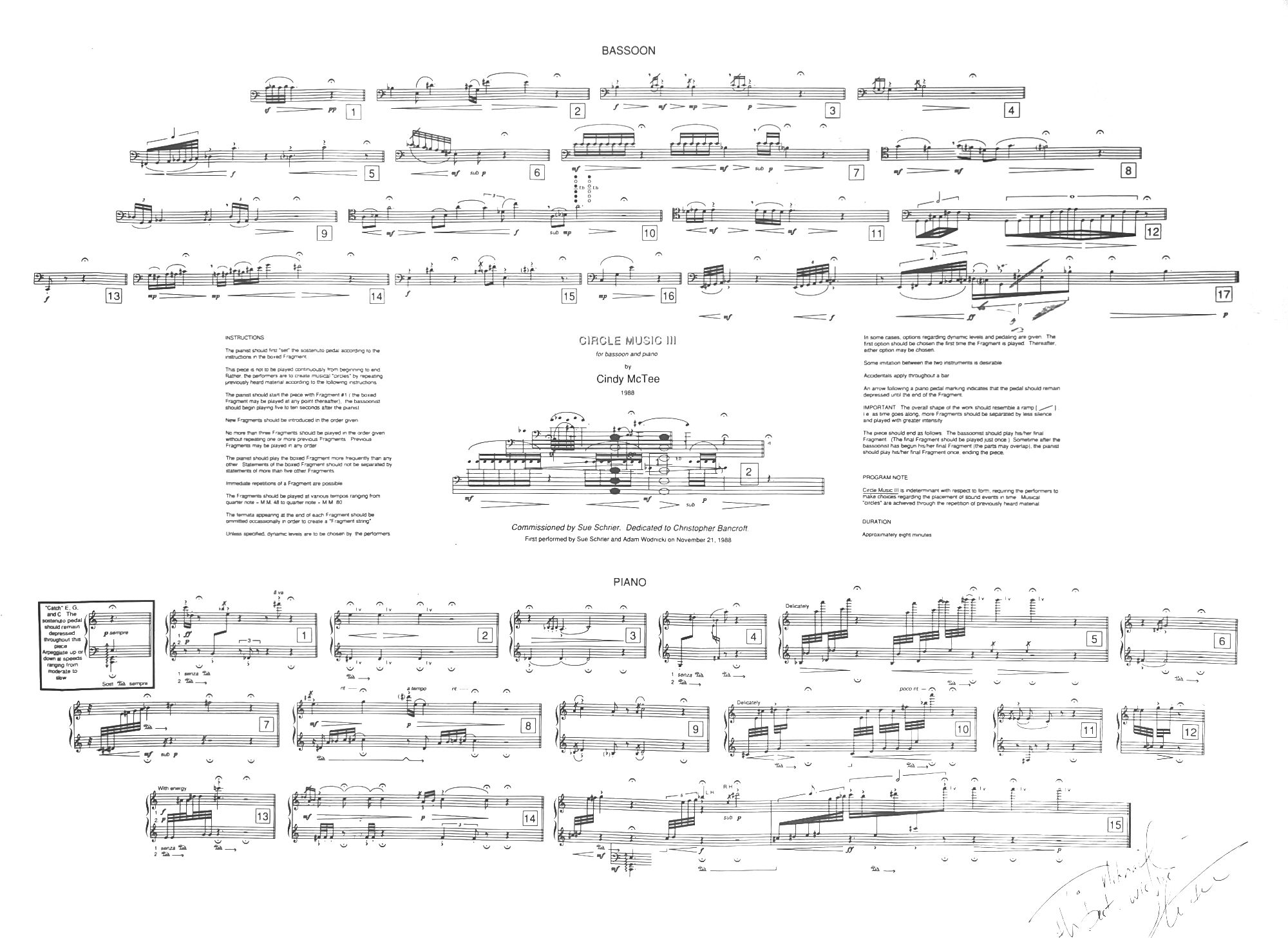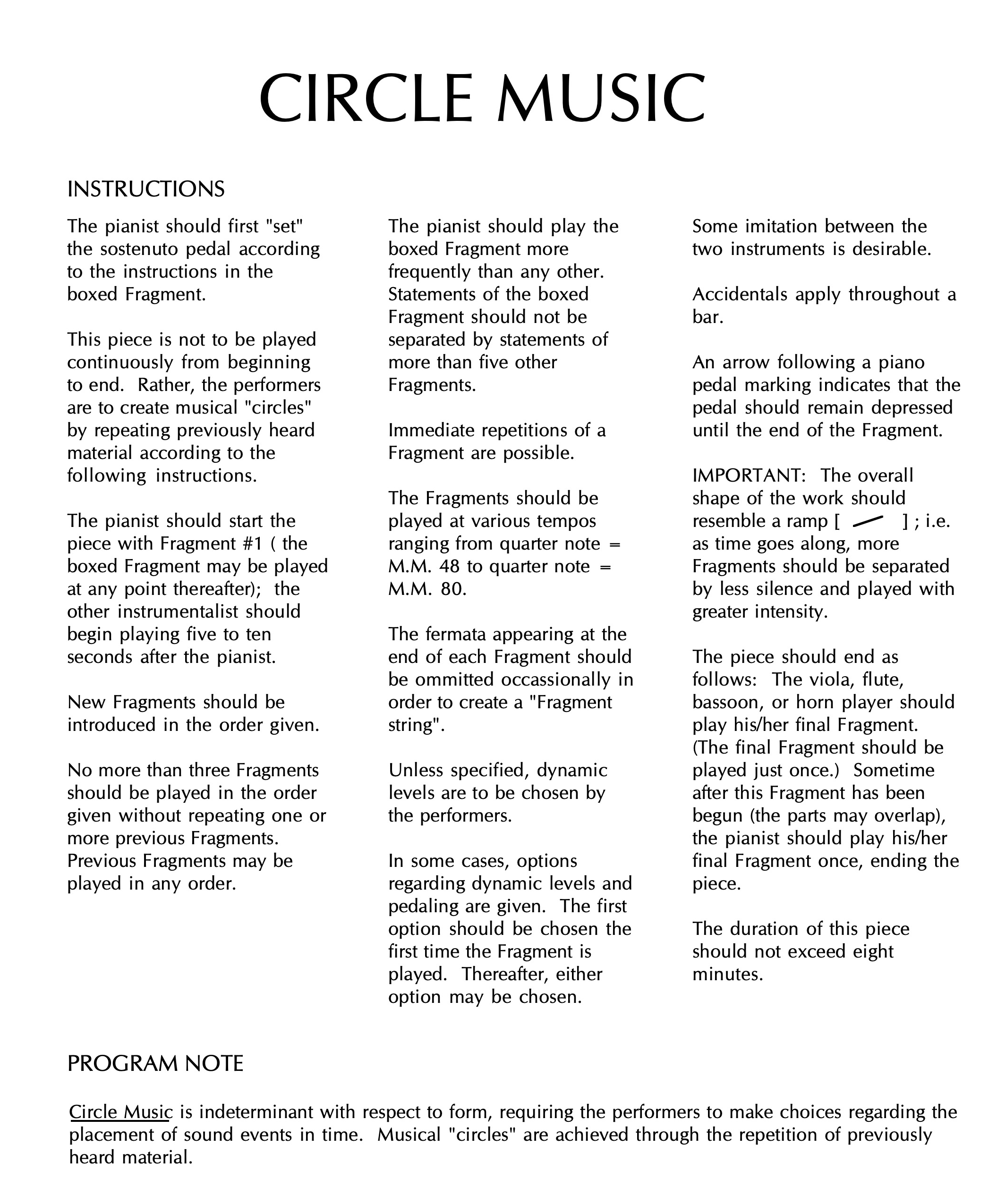Cindy McTee’s “Circle Music”
Dr. Cindy McTee , one of my composition teachers at University of North Texas and a close friend of my bassoon professor Sue Schrier (Bancroft), has been a pivotal figure in my musical journey. My intrigue with her work began before I ever studied with her while in my first year at UNT when Sue premiered Circle Music III, a commission from Cindy. In conversations with Cindy I learned this piece, with its free structure, was inspired by Karlheinz Stockhausen‘s Klavierstück XI. But this also reminded me of Terry Riley‘s In C, a piece my father introduced to me in my youth. I remember my father sharing me the article about this groundbreaking work with a flexi disc companion so you could hear it excepts from it to match the article. Cindy’s Circle Music was written in 1988 and one more (V) in 1992 before I graduated. These were all chamber works for viola (I) or flute (II) or bassoon (III) or horn (IV) and piano but V was for trombone and tape. These compositions are not only remarkable for their inventive form and creation but also for their unique positioning in the landscape of modern music. The spontaneity of her form in her Circle Music pieces has influenced a whole segment of my compositions.

The Connection Between Klavierstück XI, In C, and Circle Music:
Karlheinz Stockhausen’s Klavierstück XI, composed in 1956, represents a radical shift from traditional piano compositions. This avant-garde piece is structured around 19 distinct fragments, granting performers the autonomy to determine their sequence during a performance. In this unique format, the performer selects and interprets a fragment, and this choice influences their approach to the next fragment, creating a continuous, reflective musical dialogue. While they may occasionally revisit a previously played fragment, imbuing it with new interpretation, the piece culminates if a fragment is chosen for the third time. This innovative use of indeterminacy ensures that every performance of Klavierstück XI is a singular event, emphasizing the performer’s integral and creative role in shaping the musical journey.
Klavierstück XI
It is quiet possible that Klavierstück XI influenced Terry Riley. Klavierstück XI and Terry Riley’s In C share some common ground in their approach to composition and performance. While it’s not explicitly documented that Klavierstück XI directly influenced In C, there are conceptual and stylistic parallels that suggest a broader influence within the avant-garde and minimalist movements of which both pieces are a part.
In C, composed by Terry Riley in 1964, stands as a landmark in minimalist music. I had the pleasure of meeting Riley about a decade ago, discussing Indian modes and enjoying a performance by his son and Cindy performed In C in 1972. Influenced by John Cage and Indian classical music, Riley set out to create something that was both accessible and avant-garde. Riley crafted In C as an antidote to the complex, often inaccessible total serialism of the time. It comprises 53 short, melodic fragments in C major, allowing musicians the freedom to repeat each phrase as desired, though within the same tempo and order. This approach results in a cohesive yet ever-evolving tapestry of sound.
In C
This groundbreaking work influenced composers like Steve Reich, whose Music for 18 Musicians reflects Riley’s repetitive, phase-shifting techniques, and Philip Glass, who drew from Riley’s rhythmic structures. John Adams’ works such as Shaker Loops and Harmonielehre reflect the influence of In C in their use of repetitive motifs but also move beyond it in terms of orchestration and harmonic development. Brian Eno, La Monte Young, and Michael Nyman also count among those inspired by In C.
Dr. McTee’s Circle Music: An Evolution of Form:
Drawing inspiration from Stockhausen’s Klavierstück XI, Dr. Cindy McTee’s Circle Music presents a series of 15 to 17 musical fragments. These are designed for repetition but are not intended to be played in a linear sequence from start to finish as in Riley’s In C. While Circle Music mirrors the fragmentary style of Klavierstück XI, it diverges in its approach: the fragments are to be introduced in a predetermined order, similar to the structure in Riley’s In C. Unlike Klavierstück XI, which allows a fragment to be played only 3 times, Circle Music does not restrict the number of repetitions for each fragment like In C.
Distinctly different from the constant tempo of In C, Circle Music offers a broader tempo range, varying from a quarter note at 48 to a quarter note at 80. Cindy instructs performers to periodically revisit and repeat previously played fragments. This technique of crafting musical “circles” involves dynamically reinterpreting and evolving the material with each iteration, thereby enriching the performance with depth and variation. This methodology distinguishes Circle Music from the continual forward progression of In C, blending structured composition with elements of improvisation in the exploration of its thematic material.
Cindy’s guidance on creating these musical circles is precise:
- New Fragments should be introduced in the order given.
- No more than three Fragments should be played in the order
given without repeating one or more previous Fragments. - Previous Fragments may be played in any order.
While performers have control over order, tempo, and spacing, Cindy also leaves dynamic levels and phrasing to their discretion, encouraging a performance that is attentive and creative.
An interesting aspect of her compositions is the overall shape: a ramp [/], symbolizing an increase in intensity and a decrease in silence as the piece progresses.

In future discussions, I’ll delve into how I’ve adapted her form in my own compositions.
Conclusion:
Cindy McTee’s Circle Music stands as a vibrant testament to the evolution of classical music. Her unique cyclical structure invites listeners into a realm of rhythmic complexity and harmonic richness. Her work challenges traditional forms, offering an immersive auditory experience that appeals to a wide audience. Cindy McTee remains an influential voice in contemporary composition, her work redefining the boundaries of classical music in the modern era. Her approachable yet sophisticated compositions have cemented her status as a significant figure in the contemporary classical music landscape.


